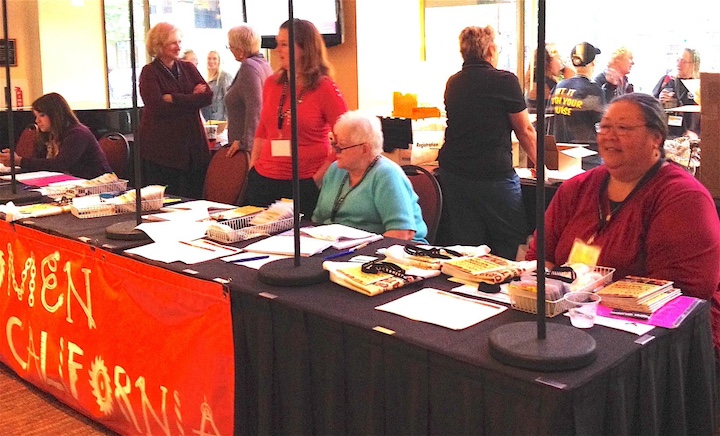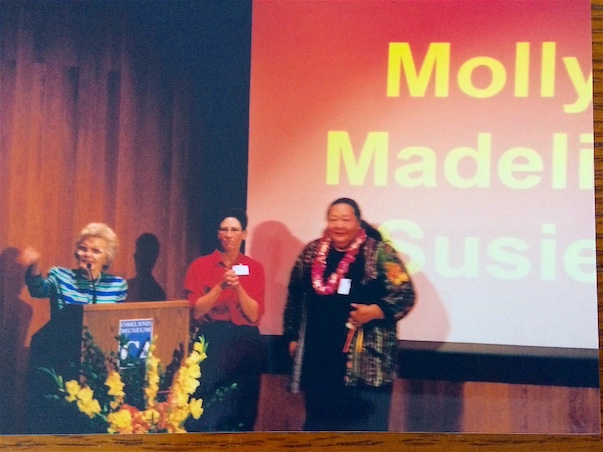Susie Suafai: Still Advocating
"I was there..."
by Molly Martin, 2016, originally published on tradeswomn blog
Susie (R) working registration at the Women Build California Conference.
| This article is the third of a series of three pieces in which longtime tradeswoman activist Molly Martin profiles female friends in the trades: Carla Jean Johnson, a carpenter and disability activist; Joan Weir, a welder who fought through unsafe working conditions and discrimination; and Susie Suafai, who helped bring women into the trades through apprenticeship systems. |
“Why didn’t the women’s movement ever embrace our struggle to bring women into nontraditional jobs? I never understood that and I still don’t.”
Susie Suafai, a longtime tradeswomen advocate, posed this question to me at the Women Build Nations conference in Chicago last spring. I can’t always catch up with Susie in the San Francisco Bay Area so I was happy to find her sitting alone at the conference where 1500 tradeswomen and allies convened in Chicago April 29-May 1, 2016. I sat down with her and learned things about her that I had never known in all our 35 years of working together.
Susie is a large woman, now with graying hair, and still formidable. She punctuates sentences with a chuckle. I guess she’s mellowed as she’s aged, but I remember her as powerful, brusque, businesslike, intimidating and a bit cynical. It seemed to me that arranging a meeting with Susie was like consulting the Oracle. She was the goddess of employment development. Susie was, and is, the one who understood the big picture, employment trends on a regional scale. Early on she learned the workings of the apprenticeship system, and understood them better than the men who ran it. I remember a workshop that Susie led in the mid-70s. She laid out the complicated apprenticeship system for us tradeswomen activists, taught us who were the men in power and how to approach them with our demands. Susie was passing on what she had learned to a generation of feminist activists.
Susie Suafai came to California via American Samoa and Hawai’i. She was studying history at San Francisco State University and fell into a job at Advocates for Women when she was asked to help prepare women for apprenticeship testing in 1974. Advocates, in San Francisco, had won one of two demonstration grants from the US Department of Labor to see if women could be recruited to construction work. The other was in Denver, Colorado. These were the first two federally funded experiments to recruit women to do this work. Susie went on to help place hundreds of women into union construction apprenticeships in the Bay Area and she later became the director of Women in Apprenticeship Program, which had spun off from Advocates for Women in 1976. She also spent about five years in Los Angeles working at the Century Freeway Project recruiting women into the trades. Electrician and filmmaker Vivian Price made a film about that project, called Hammering It Out. Susie was planning to be a history teacher but she ended up being an employment advocate, and there are many tradeswomen who credit her with creating their careers.
We are about the same age. I’m in my mid-60s and I am retired as an electrician and an electrical inspector but Susie continues working at her trade of employment advocacy. She’s now working part-time for Tradeswomen Inc. to invent new ways to bring women into the construction trades.
Madeline Mixer, Susie and I being honored at Tradeswomen Inc.’s 25th anniversary gala in 2004.
Now, about Susie’s question, which is also my question: why didn’t the women’s movement embrace the tradeswomen’s movement? First, when people criticize the women’s movement for leaving out tradeswomen, I always object. I say we were the women’s movement and we are the women’s movement. I never felt separate from the women’s movement. I always felt like I was in the middle of it, like I was part of it.
Like Susie, as a young feminist I thought that employment was the bottom line for women. If you couldn’t get a decent paying job you could not be independent. A young woman in my history workshop at the conference voiced the issue. “If you have a good job, you don’t have to depend on a man. Once you have a trade, you can be financially independent.” It’s the same thing we said to each other in 1970.
My mother had very few choices and worked as an underpaid secretary all her life. My generation had some better choices but not many. Most often cited were teacher, nurse or secretary. In the 1970s I found other feminists who agreed with me about the importance of work. We founded organizations and allied with lawyers and advocates willing to help us fight for laws and regulations to end employment discrimination.
Though I participated in the other struggles of the feminist movement for abortion rights, for childcare, for equality in marriage, for an end to rape and discrimination, I still felt the jobs issue was primary. And for women who did not have access to a college education, trades jobs and jobs in the construction industry made a whole lot of sense. Ours was an anti-poverty movement. We talked a lot about what we called the feminization of poverty. Statistics showed that female single heads of households were getting poorer. We thought introducing women to trades jobs could reduce that trend.
Our issue was not at the top of the feminist movement’s list and I think there were many factors that contributed to invisibility. Partly it’s about class. The leaders of the feminist movement, mostly college-educated women, could not imagine themselves doing construction work and they probably did not have family members who were construction workers. Few of us knew how much money union construction workers made. For many Americans the idea of working construction was considered a step down. But workers with union contracts make more money than nonunion workers. And, in general, “men’s jobs” pay far more money than “women’s jobs.” Susie figures she would have made a lot more money in construction than she did in the nonprofit world.
It wasn’t like tradeswomen didn’t try to fit into feminist coalitions. I made many attempts to collaborate with other women’s organizations like NOW and like the San Francisco Commission on the Status of Women (COSW) of which I was a member in the 1990s. They didn’t brush me off, but they already had other projects. COSW was focused on domestic violence, a cause championed by local lesbian activists Del Martin and Phyllis Lyon, and they had created a successful network of organizations. It made sense to not spread ourselves too thin. But at least I was able to expand COSW’s attention to the issue of on-the-job sexual harassment, a universal concern of tradeswomen.
Tradeswomen collaborated with feminist lawyers—in the Bay Area Equal Rights Advocates and Employment Law Center—to secure rights to equal employment. In these efforts we had great success during the 1970s. We joined in coalition with racial minorites to fight the dismantling of affirmative action laws and regulations. In this, too, we were mostly successful. But having laws and regulations on the books is useless when they are not enforced, a strategy employed by Reagan/Bush. At that point the returns on our activism diminished, as did our support.
Funders didn’t take us seriously. I remember traveling to New York in the early 90s and meeting with the Ms. Foundation seeking funding for our efforts. The young woman I met with seemed anxious to find a way to not fund us and to get me out of her office. She categorized our organizations as “associations” and so not fundable. But I felt her rejection had more to do with other factors.
The barriers to women in the construction industry were seen as too great to spend resources on for too little gain. In fundraising meetings with the Women’s Foundation in San Francisco Tradeswomen Inc. was told that projects they had funded to support getting women into the trades had failed in the past and they had decided too few women were impacted by these projects. Many just did not think it was possible for women to do these jobs and to be happy doing them. But maybe that’s because most of the organizers couldn’t see themselves being happy doing them. They (and we) had internalized sexism and self hate. But organizers were also practical. They (and we) strategized to find ways to impact the greatest number of women.
A big part of our campaign to get women into the construction trades rested on the ability to get the word out to women about the money that could be made in these jobs. We needed the help of feminist and labor media to spread the word. Until the turn of the 21st century labor unions in the trades wanted nothing to do with us. We were accused of taking men’s jobs. But I think feminist publications could have made more of an effort to tell our story. Whenever an article did appear in a publication with a big subscription base (as in Ebony), hundreds of inquiries came in. High wages were a big draw. But traditional women’s magazines were only interested in matters of style, such as makeovers for women with “hard hat hair.”
Our fortunes changed after President Jimmy Carter left office. While some nontraditional jobs like bus driver began including women, we soon realized our efforts at integrating the construction trades were failing after Reagan took office in 1981 and began dismantling affirmative action programs.
Susie corrected me: “It’s true we lost footing during the second half of Reagan’s administration but we also made some headway in the first four years of his administration. At the end of the day, Title VII (of the 1964 Civil Rights Act) was and is the law of the land and we were willing to and are still willing to challenge under Title VII.” It’s this optimism that keeps Susie going, and the conviction that we can still improve the lives of women by helping them make careers in the trades.
In retrospect, whether or not we were dissed by the women’s movement seems a moot point. The women’s movement was an amorphous collection of activists with little money and few institutions. The partner with real money and power that could have helped our movement succeed is the federal government. The institutions we built in the 1970s never recovered from Reagan’s slashing of affirmative action and job training programs. I believe our efforts to bring a critical mass of women (at least ten percent) into construction trades would have succeeded if the Carter Administration’s programs that we fought so hard for had been left in place. As it is, the percentage of workers in the construction trades who are female has stayed at around two percent, roughly the same as it was in 1981 when Reagan took office.
Read more of Molly Martin's profiles of San Francisco tradeswomen in Carla Jean Johnson Presente and Joan Weir: The Only Girl in the Welding Shop.


